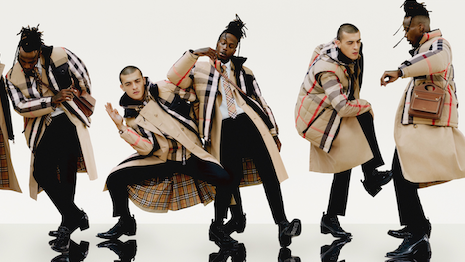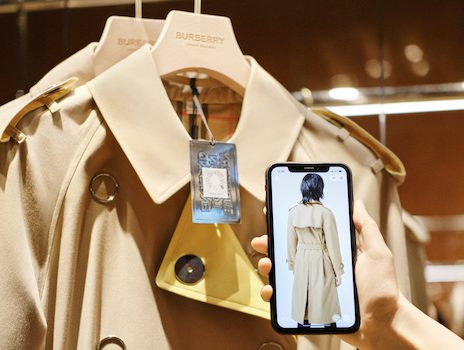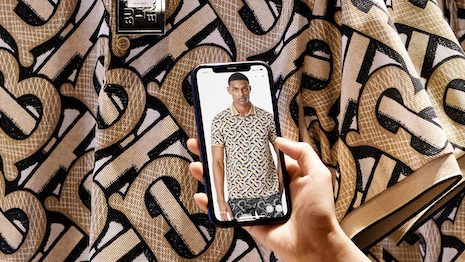Burberry is driving growth through inspired customer journeys, bridging the gap between digital channels and stores by leveraging digital technology.
During the National Retail Federation's Big Show digital conference on Jan. 14, vice president of digital technology at Burberry Rajeev Aikkara shared insight into the brand’s efforts to redefine customer experiences and enable cloud-based business agility. In conversation with global retail lead at Amazon Web Services Tom Litchford, they discussed different ways brands can leverage digital foundations for successful businesses.
“One thing is for sure and that is you cannot predict the future,” said Mr. Aikkara. “There is absolutely no way of knowing where things will go, so the number one priority is to build a digital structure and culture that is agile and nimble in nature.
“This is done by maintaining a drive for consistently creating elevated experiences for your customers, as well as by providing your colleagues with the right tools.”
Pioneering the digital space
In partnership with the National Chamber of Italian Fashion, Altagamma recognized Burberry for exceptional digital offerings throughout 2020.
The brand was awarded for standing out for the most widespread presence on ecommerce platforms, both directly and by online retailers and luxury online department stores. Additionally, it expanded its online range and social media presence, and offered the most extensive content localization online and through email marketing (see story).
“When Instagram launched its commerce feature, they chose us as a launch partner because we were one of the few retailers who were able to switch over so quickly,” Mr. Aikkara said. “We had already built these APIs to allow for effortless integration in a matter of weeks, rather than months or years.
“When we look at the services we’ve launched and how our customers engage with them—whether they are through our website or ecommerce partnerships—engagement rates have been extremely encouraging,”
 Burberry stood out in 2020 as a benchmark for ecommerce. Image credit: Burberry
Burberry stood out in 2020 as a benchmark for ecommerce. Image credit: Burberry
Especially with the onset of the global health crisis, brands have had to quickly strategize creative ways to maintain engagement from customers through the use of technology and digital innovation.
“The industry is going through profound changes,” Mr. Aikkara said. “We’re living in this era of consumer technology innovation moving at such a pace that is unprecedented in many ways.”
During the summer of 2020, Burberry promoted its Summer Monogram collection with several digital efforts from video games to collaborations with artists, reflecting an edgy way to connect with young audiences (see story).
“There are a number of patterns emerging from evolving innovation, all of which are bringing new opportunities and challenges,” Mr. Aikkara said. “First, expectations of customers are changing all the time and the bar is getting higher and higher for personalized experiences.
“Second, as technology changes, it also enables almost every aspect of business processes to be optimized,” he said. “And third, regulatory policies around the world are catching up with technological advancements.”
In February 2020, Burberry debuted an augmented reality shopping tool through Google Search technology to allow consumers to imagine the British fashion label’s products around them.
“Burberry has been a pioneer in the digital space, so even before the pandemic, we were already positioned to further accelerate that journey for customers using digital channels,” Mr. Aikkara said.
The AR tool allowed shoppers to experience Burberry products embedded in the environment around them, aiding their product discovery and shopping process online and through mobile devices (see story).
 Scanning QR code on Burberry's classic trench coat in the Shenzhen, China social retail store. Image courtesy of Burberry
Scanning QR code on Burberry's classic trench coat in the Shenzhen, China social retail store. Image courtesy of Burberry
Towards the end of his conversation with Mr. Litchford, Mr. Aikkara touched on what the future of technology may hold for Burberry.
“One thing we are looking towards, in particular, is storytelling,” he said. “I think technologies like VR, AR, gaming are all going to open up new possibilities for storytelling.
“Additionally, we are aiming to transform the customer experience by focusing on connecting our physical and digital channels—this will be a big change in terms of how we utilize technology.”
Innovation and responsibility pay off
Despite the challenges brought on by the pandemic, Burberry made good strategic progress in 2020.
In its HY 2020/2021 interim report, Burberry had a strong response to product with marked increase in the weight of full-price channels year-over-year, showed growth in leather goods, attracted new and younger consumers and proved growth on digital (see story).
In November, the brand teamed up with English professional soccer player Marcus Rashford MBE for this initiative to nurture the next generation. Together, they pledged to support youth organizations and connect the community to those who are working to create a better future (see story).
“Digital transformation is not an easy thing, so in order to do it successfully, you must view it as a collective mission,” Burberry's Mr. Aikkara said. “It is a puzzle for the whole organization.
“Companies must also change their mindsets to accept that transformation is a continuous evolution—there is no concrete beginning and end."
{"ct":"E429qeJF2I5yP+L2kmX6eCobBFpWvMBLUkm4+hdqQ4Ea5NWrjvDcGu\/AwbGfzZtKOo9\/2dDYpzegyWDeQ1sbQDIIk4wysuO\/PKYGwfd445xpjsF\/biPlYvKKvaa0G93olhKvXZzxYH2tHJWiLyN3+9YRgct+ljQ24l6+A7HEy5CD\/7PoeHQfAb668GKU3b8RBlP7K8cS35CwY9Hm52h65FdZ0P\/tE\/TLVGYfompBeYsDyVHT\/tgJd2SvSmuZENGbQ029oXXaNnZVOlH1w8CyLw1q59ZMuO2zEOYv9duR\/cFmcqIYLClLbgm0SPW\/too3kGgL\/0r86ceC66TezTo3agUNQkb5NfBukAyR\/PTEy3Lu0Yj4FtZ2jkEaxfrVbnLLnT+l\/eeHHJsPqj+4MZ4Ag3aBO1AFYODVMTjWmhHp7wHGx\/lSb8TBOSCWkI0Ogr331MJqEorirQTFuxNKekl2nd9e8iVGUPRmIpBaKPXKvCwUI82\/hkGWuqtrktCiQW\/TqD54tdI\/X8cHOEtis2ufdxEmIfnUTwuCGnXFnhfHkXmH0TDSpPAFHTEud5Hw4866tWqRz7hdZZcJ8YhZO1fGKaW3gHOkVBblOOkrgHEFPO6NqgtgacxPC\/lrErQBSJ9hKRXBA1Ix1+It\/yaIOpYN3LqtVGvkiAKlH\/6qdirpJtD1RauI\/DCYZY4Y5J50ngfH\/lT8kAD3AJi1bAAwuhG0Q2lb9hAVdIdv+TCjhSWeqbFnWuEy1eXNOiGdfvIZS3tbTSOr48ckuvc2tdkIwAvLDBy6Az7Z0T8k+jqJBL4qSb23dMx7\/8M0T\/rz3ZEsYhvtahBqyHjJIj\/\/VxL64FZahwkLMLbH37xM2vCWc3XXgb5zVFNRrQeYjRgwABhr1IIojHxMmTLhz9zsDKFiD8FNoL3lDUpqZJGz\/9lgCHxVOaJoNKZrgkFpIwmpLAlByDEvZVDoaJtvW6gbsFnpduy5bFZQQ2ZnnHL0\/q8eja7yp23YMGPL76TUylmFI6+m4UTuvT7IX0QfZ8SQyixLTbL9xoO7eWrc68fKyIaRc7dUBljQGx6o0LDxF8aT+gBVsKFEqhseZuj6ZE4Yyzu1an6hQVgcuOZkrWen1SwsEW47AXannp4B4AfWqIkZFVUQE2nfs1Ypx4Bb+62tmntl8IQACxGmGkztv7GamzoN8RUv5V6j2GYAM4SxKb10cQE+dHtgEhTEL7pObUrfzajSx5\/tvJoZlLLIYjiSTVKBlmPVUD00YD1OtuVl74sXNI2Pmhj\/Y3KltVgkYRHRgjhsToeFHQSpoWUQRXhrNlkeJirCL6IQwK\/KgsmOlD2ADhBFF\/it8qDuNYQ2PGDA5EA456ptz6eQ37hM\/SjYjQd884GjWG4RNtPxTGvAa5UB8qOEfWoU6NQD1\/tgUhvy7YQYgTvBKFPtHHBQMGNPQhpKNqqt4fL6jxWYHEiRZKqAwph7GuB5dCycuPYvJuMQxVkp7pRQtjjQQ0ffVFeYEyhbS99\/enStfrfHqYnFPJO9BhykICgRerr9DRrFcYv8wIfF6Fq0g0cCJFtd0Bl4wLMLJ8ZOieIXlk87nffJLmK8+9pD7PlRoQxVT1zgszc4n2j4cf\/W6OEeX4Prr7R8iShiKmyJznZFsQ+xWhCc\/qzIlROwaHtBBHG5QAtRyVclEu9RskKdGktWaz0Wh8ft3yYk3\/mKCWen5NeGSgM9k4uIgClf9Ik7nmkufdUHhII+Tqd\/SrG8S1aXfLxQ9FhZKfw4\/WQxhP1L3FOLVbwYadYHL1VEvpmcgkTDdIFcy1a6twjIq0vPATa7\/tjwZjlD0KivCDkAUDWK8ROEGYoGGXQli\/l2c3tJZzyDaOX1j33768N4Ja8e\/r1IKMwrr7vB9eLXkEy7TiOJXh4zg25qCD5mHp14sz6mgt10adOLHbeZIrV3RHb0QTpCfbTuxcX67mlXTBtKXLKpd7zdsVWorln16YBxqIsdMTdVzrQEfrs\/KIg9o5doucNAHlpUsRYHW3108hJfNQ9fC4ESqyzvkxfhAy+CYIKjeyEdnngZ32\/sF+vG2ImynVxt7YU9+\/BMaYKkSc8T9XOszB0PjHL2b+uVJDCu88m5d4fb10XpKmAPUtZhWML3\/rYqXGV7sWwnDqwkz86VLhhxnyAcrHf7kuvnf2LYn2m+OONf4OFxP4L3gYQsGHcX8+\/llX5o36SJ20Zql0An\/wNzpZ0JBlJQnps7KltrLxw4+Rq0TZrnjqDCQiGaY5j1Yw5DmorknN\/mnk8FJzNjlfowPgw1esBX0YhWC5B5FFQwBBTxBwVhQznnFnjk5m++jmYmjQupGlO6yVHbK+LawPdYgqPkQWjzUFOo6ZRlUS\/Ljqp92y3+iFsc83KtHn7U8QA2nI+Jgh8jir1qrhPwuVf6TojP+rslyCF\/c4jjqzLwwWQkMzljPmyuj+ZKYrngv1qg1MTHPBE8RTWA62c+GcIXR5dfYDxoFdaMoXSKufHq6S4Y3vYbC5NMKKxe5BB6fS+g9sIckUbSfzH3BfyVetuk+RS6D3XD64aR6aGgqBc54ZkIzM2yLdJleA1d14pa7YzJyHhiYfkHexFyTdybHel+fsW0MbA2W10DCElcXtRnev3ME5RtmIyYOpI5cVsPfhV0CBpibiLsclYmLNsmfwnu2M5LJSuZ5lvG\/jhBlHiTq0cg8QbmgYv+cSeF9MG8auKzmtHCZvDXgDK+TcSKyi8OCnRyMHdGhXVTLTVVppCDlycC7Q9+GYp64D5MV5t\/Xk5sU7wRqm8gAjZJ2b82MT4ZLx4ygM+O7mq8NFTsTBFDI5QqDQmNUO\/dN+UqMwekVbFLUuaOY4eCau1q7UmBroha0rD7YrqlENd8Lz83YfAbSVi3Cz3L35XQsaDGJVlsgqHuYF5cL\/xgYslhRJ4bws5quU\/suaSUAslFvmTzG4r8scS886FV5IQ7VC0QEA5ION9QOyQnYb337w4ieli9RrTbSazddnlVAQhvl+yWi9AvGDXBHMggz4lXtWlXkbchuCVyY8TcfAjNWIRsAet2MQ68HgkQ2d0XCI8WRJi7fRHbgMv4HE4fci\/AD7gsi+Xjrqv\/KQ1OOsFQcvuh6OpnRQ06Z8xVE8bHDyJo8OvNospuB+3AO3FUvZCRn+qWXYZK8gyyBU4thNM8U\/Xzr1mfRdE0GaAi9\/sHGKV0mSZ0Wx4WOm4+bOxhr5cAjqFC5C4NKaC+\/7m+RYul9Lk7Wc0tgMMUQTbpR1BcB0fcNsenl1zn82veQG2tTqcimGMe8mHJ0E0Xw2r+dDHVodFnhFYMzL7Jw9DyDhhBksjpfn0Av7BSWPyrCqDwx8X7s+pCJ6VY7Bm\/wfPEmcD6cyOLwQEy+GwdAsflUIu4unEhmR7QaCYRioUHXkn\/qyQhn1T52yZMEUOvtcVqCdRWvZJB4nKc\/LAxcFUHTSNPJLcIPDWo3VEPK83bkLgmDYZNKtpmzOO90XvWCYqw214fOx2QXlSl6TiMSADC\/rO\/FBcpD55PjNUXOV25dQEpCJj+RDcjATvQcpPbB+N\/MtMp1wioPOsIklGARb90KhRg\/tBJnifKY6sjjyoazx\/tP1t\/n7gL08vsczd2qHBwhdaWgDBAzye31jOFlPeIAAVARHBexsal0b9fQm6NGgbsY3zRhUnl72oZecmzjPJ5baSmaJH3QGIyZu4aVW8MIVHpXbKUQu\/aubW3wPm3bFk53EF2Ws3Z\/nIfQMsakVzKjIbjfKpv2dAWlPk4CZ+XiyvwMl\/FMVPTxSyqX0Id38dS9kf6bio3O1tDfh9rKKSQSpuPWOl4SwFuITSAYJEpzCchTKJpjGLP6DSNxr6UgH66SACoVaOJ8i7tgz9LLL6kSwJeWoWOdxnHQ2ChzQHuvIdNqifyrSIMfAWXHgGFd0AyLYc43BUL1KZb1esJ8Bt5eLHiWAB9WD3ZUij9K+55z8pisHSHTH+sLfKER3wm7LeadobXl03avqXnMXWjwROZyf5DdlAFfpPmo5T46N6x9BL4U2aq6tt3HZeodq5Zm5ukOT5H303vmJ3oz3EIb+ILi2820xH72XrS0kA1rW23acVgG8scb5+62ObS4j5QarrYJ2qNepSLdaisA0xeE9fEvW45R+pt7d9ExEZFkSn5MOIehlbj+wtKBE07XImhSrr76deD1CdSQUEQ2Ds56gVYcN8seU8TfbYFS4AFCXXWZ07pHKrZv\/X0lVk53EmFLMODQDn8Z2J9oChwYuOyud\/5NkjacmFi9RXrhdWumuBCLagRPElnlna0nN6u+GvzCsdKVqvuhG6rfyqSs\/xiCmDWSIbJoDa32EL0jhTjquCeb1BEaK4rzS0y0l4HffL142OKnSey8a9\/GQZmpG3YlXccu4EuDgClTmIQiQB0sszWc5OI07fKihCOUeWZ9k8m2dkKWb7t7Eidsv+WDBaVUy1k2nDE7q\/EgA8SbdiKPnhPE\/X1E9U\/C8hIJ+4EgrfrExo2ztfEJmehTPlKeeL7sHKEaaWNloQAbhSmd6pkiYM8A4gcU2VG2wqBPRYwwUFu0djC4HjuXRqokt0+JNwkbQxkZWQ8vPNxFVVfOG56Y3G+0WGjS7bhyJ+1Xy4\/gySrBu1WhB0xUkQRZNIrCdk3BveBF2+TiepYyGpNQRGVCC4grNFFBkNPkmnmZNHX+rKiBvpfIZAu2uR58vQUxXVbTixVyDmUZEkck20ZvjTWlvcVBsJDhK4HrBOA\/n88DQ1a3FDkaq0PqOCrQd0va6LsIBMyVQqGP1cEaQ\/DTuo9ENlHAkoVq7V2+EaKu3ZRlfaGl\/\/WnWbxmmj4pf3gDhh6mvEkDtGR+DRCS3elCvZcB1NVu5VX1D+RTBLIajJFxF72m7aa72mtJJv4V9rkqYVVxtHQpZWbzUrt\/yX55is66GCRLbb7y2SGNcizFUman8nRr\/ukylTvuByFb\/sHna1LgM8tNsieTXqgS0HNs8PmBhj+wDQgT\/X956syvoWGMYz06FnAKZZn4WSwJ5DkeIMnkXKquOJSE5jekT\/kbMNmWTeSoYjAYoAq0OC3lgjcdqKyso6jmAb6jnOpxDaNLhV8AubHWoxtbINfntujTp\/fKO0yPH2ii5NEiRt08It8nAmGfBX0\/RhkG5I1jzD6CzstkfLw6PxJhD0Zkl3YpI2+HC7uqi799ZxGKmBnF36mOOaDhTfVRQ1nD5+AciOghbne\/GnZj0Q1p5TxjlyrdclxQdWcAN+v7LyXnqmrHiiy1dLrbGTR\/C1Ij7t6Dhr1VaHpUYK6F8U52ONtiEGOI2Y0rusdml1Bba60rNDZbsbM+qzjsT63iW+UaRSFcTrEEz3nfaZeyMifDFq2fBE4fkTT5okCvVSd\/2h9zU6q8LwNXU4PG4cjDJcenGroSrDocotxN13TQyC+cBV0imvqJqXjy3442dRPoBoCVY3cfgGRSQSFMYZm9hB03V4nmSlERFAVh4IoU37O1aUIAeEiut1ylcITyjRrC\/OnvbGH6wPyI7ztvyrcQIuYTfNywL+GXRl48eudlXrZdQg3AwUe79KGmh6r5IJJyJ6mzIjFlzoa80lGp8lJwIUWKN+PytD5Tsc4VAej+\/ik+qsqIeoildiAKXK1GLJzy39s+LnUhaN4HMHKNn4z14zKsz3vPGY50lDhxx1M+rygTpXbB3lWp+LGJ181BLg9BCoNKGW1OZEU2cB53aK\/z40yFH7veCrhvDFRLqtPth+nS1TrNN0Y8nqcrd7EkKvzq9gIXx+DENjiRxiDwGFNYzlo88CbctGfGu89eWxHrXil4gAokfpQwySQSRDmVMli+BLoNE0rBXgQz3ti2hbFP381aVVb92FGnRQnosC5aG3ud6adY6ogJW5e5GxPzlp9UCbKlIhG1g89OckIHmEkAuaqbvw6Ne+AKXj67gG6r6Souilg2Cjm6R50c64qlK7lQ9On5SBxzq4VMxxAj\/0vcpJyooQx7j+VCJu2OZ\/yz2mNsVJ\/Na8+X3FAlcjuDv7BvNyXlouL\/o6ckChxJmdYq6dnWtSSRiw\/PXZfNoB4ae5MLBe\/XpMMuFAHxPhZdyAOT4NDhRS09Ch6C\/gsFj+\/BMQ02PHOWxT4xzeoSN8feATx3BBjTqeusIn7CXoCrSPjVKMvuTEMoXLcFFlPBXcJdF1oweyj7mXseHhG3NW6AQlOAxcZFKrKjsGcneKMkLLHPQtrWfJMsgjv+cgMGjUgTiqNEqh1OqXP5QMHiXocWrZoq\/CFaJhrPzAO1lMAtmtdVNInvrWYiYSYYz1EcXTJoY16JBgEe8JesngnhMIyvq\/7H5uCAjqzmRwJvbLS1bJiBhlHJVjSJulbemsSLrvpGZbOHE1zW19lhZ\/WzrgdjM93GZ\/dn\/NvS3Ilm2O8ibqQPAzFfK\/4hha+xLgmOgvsryurrLLbyMUSEZcIRrKjzxsE+2kyT+vWJ0o\/YLCXyewvIqykyzG3HddAv7kQwh8qVh9SUlq3VfLgxe2ZDzGjBqXydVP1XlrJp24+zEb7Ae\/XO6RZxZCuojMD\/0Tr6Kc6ek1d0V4DSr4SAUzP5AHuKPBvZ\/zA2heE51TjOfKv9Va6Yua9XNlZ\/95LBVWawEnkp6QmQWpRd1rcpV6tp2uKWW6SuZGoy1eavkxcUzG1M15GAOpFl5JgE5U71IvSDzcpOvNXq6P0cWcJuXRUuDWwCs0yQe9qfvRxUaOAMikVTYj5VSgyMq8LtXa2dLMXqrK0M3cIh3dYshe1rWO6\/B2LLDSiesrXVX09whwKq0Jv99opQL4E7blzBtyj38237KCyYsfmyXjHj3lX71tZhUguCcYcVRcRX+SeKOWghFIHwxpamPo8ZZ539LY2xIH6c\/FfN5UH5jarATFSYj+GLu5kmlzAhAVa7JObCQzzNsRjCkg1Yafv7dfo+JblNFIt8ERXD774mpYAmL+X8zcUwmpwIqs782g8l52QFLdLcIwDWi\/Yn93rnVV7GLgfcpeXHbClrzYjjBCS9SsyQ7e1OUw3CH28wMW4LuziaBG1vIuIgZ\/Ck5zJD0k\/PosqFfIw7\/sYOrfvf1dwSeN+BDRdRVITsSSGJOEb5BW7l\/uyZo92+\/gRDOt6MX7umQJMryK0LdmNL4ArSIf5ConsSlnxwUKkJaLfsYDz0Ts0sWVEpZC3cUffXcVwO7jfpaEkYJF+LQKxApmx7QBCAV\/XSMtLD1MYIotNjC0GP30Sj9cmANmUkQmMBxa10A4WZgYcx51+7ZCG4ibQ\/+bIFOKYLvEbCIrqnGDFpJGRhF2cs8Swa7GbDqRKnZivFBOnkNhXjM7eh+lA6mqLS6PJG61Q+zP0v+ODsocfzBc9pWbGlNPaZ1JOPaqfJ+Z2+g0ISj\/Wbg9RlcQjVHx2qIbBRoXIfblQY08OSzD2Xt8x0GSpvDGj6TuBwHzCXtn0lWmoXOkHANbQiprd+cKad8JJFSz9PQAylmWx9p2m2\/dj9Aa5VvYly1eQcpoyry6ZqQv7+qA7iE0oaIDaHcsQjd9J\/\/ou7YsfUpPX+pHuAGHO1xeMZnTWw0YdI7IsNf3HVGdyCNPTCX10cCh4yK9XDKnWUJROC2rt3T+rCkrrMluf2b8QsvASFDjDEcqSbukGYyDICbbBBxv6eD6rwVA7NMCvddu4mbUgPd7i30sk6\/WAES0yb+hlXfhIMFtT1icTC5lCvXaPGIbeOdIDR7JzyfmV9Tj9wXmexHxiBdmlCjzku5RT70GMJKic5p8s+\/9T6cMZ+FV\/4f3h5RFZzw8ZpUFOAaYQsYtz70FF1ArNGon2U+O4xZvglKg50V+2CaLcUBUzDSMISkJIemHu2C27coD\/djE7qD8\/URuRo4chEG71+Q+YX2DiIneF2nwkuddIVod5njO4aJtQLYMoxGQq9ExOgi5o2XCB3uBaheA2G2DP2408NGXPOmzsX2IZzqGrD3G6mwynmCNsPRBgKVMYPqS3twVgvukr00Cnz\/ItSGUI9HiGtcuYvN4txjlP4EUfvHNlok4p3g5gtRNxisYl9t2kIFt18bpiWMgOzGoGNSn5gc46v2RVnhuSQUdmxR7qaML8fjyTWX1s5z9+8YsQBnopRjP52vnNwhEEfWGsxnh38n8xyW2VssNFE+eE1G2ni3l2R7XlroxhbmZ5obozYK3ef88Z34dRFFSCHiDnj7ewqRRrD\/Bxs9O6jDcYA7Qsp+Glq6qMv6kxNPh94ToYcrMd83A8beFlIwUO\/J+CRP+u9ZyN38Rp7x2UYHxOSre9H5p7iFwaTkX908KW\/nQQZegVGtTuYWi4pEFg7aIlDEQBcA3KrVazQH0jcRV0h8U2Uc7RsfUQoGyJcSmegfhGn1FHGGM+FyS\/EmZ6cDZO4WryoDnsZAWEIMWpGHoMlmTXqYDcYeWHF27xXoHsq2q0AEHidcvLPr8rae3HA1ng94OapxioZm907olUHoRz1rCkJAnBAOLC48QQ8bo8TfXSRK8bhyRLjpiVV67UC6NAoEM0LNKFMBFF5y06AOVxR8Y1PTmS7hvhubqRogA+p+w2fGtLc3KFq\/mutKYS5R7qbd4QtH77adR4e1V07GBdo2KoOF3mHnsni7JMoTsZG37stgy2CIScZpycrQfIupMXoqIcLHUfnLrvBM\/kaI9qMcINvoNyGt\/D25Mwl49nL1BEpTRGVMiybv\/s1aQfuVO47i9NHN\/VL5Sav1PThYC2HoAPanZ\/Z4pFTfU3f5mLgBuQBYKO7pIgSqpbll35sw7wVnd0NGXEbHNnUwWPU9Pieh4zlhnz3YcW7qTux66+aDewdQVNd3O3M\/WUzEXY89v0fvYdJODfWnlCMaYRfjyedDVm8Of80RsCr4HLODgPARA2Oi\/ztXg75+I9tUkCtAhKWkntcE+I3jMQA91KChrckzlUVqbopTnO9AqwdPVIFmDC3d2o8jDrNfAWdJhFOArB6fmy3zC8VFwtRPBHn\/IHyYjvuOt7W9P1xFHyZJeMzWDfps27RP5VNIFl0hvHAiC10hMEhoSVEl3Nmry8dtgJ6Fav9\/x4FUPaw+afnAjZddMSGEBEV2Cxbcrf+yAjLG6Px6zB5j7PNrgeJSBUHRYLdR+KNgKyT7kUMKchVCKwbXwx0fvf6a+tBo3P\/KXQyHTl1PiUVrKxE4W90migM7k5x3JxtyFfhx9FlqxHPcBsYgMOifoZUeiU2bJbjkkGXO\/IPzWujLMCTIUzZoMYG0nVQ9oFq0C55jpA8hN4z1O6ocxwVfGxBCCoqS47izjZV8wfkEP7KmJvw8Gj28KvXmQnMcVshQHfaIiO7tOYruCa4Rxtmya6mu1z0HxxC3yhkgqdOwqp5SPtLXbCSczQDvuujZ7r57Cy4EGamK54Rj3wQAQoCpwLwxI9pB4\/0rGiwZwMk63r6A7Ke2sznqZWIBeI1zdM\/VbMXJSEFmEXMKX1A4cFy17HSf\/HP0RjlltgxuD\/RR78ZCM2NQassLkedjl3Rbg6UvPrXRFD3qJvpa\/mlIFN0mvF7SbKjsYPSLJ\/UMdocaeRQ2zRZA4f+Dg1mt0VCRzTAT2z9fLA4W4A+57mtgFJD18v9NCn5mSa+E+ID73fWlqJutnjdD\/r4JtUp6aFix74t6l\/f42RG9hIn\/rbxKZEuQjT5N9tjPoaQ9uZgMyd7M1z4E9ZHI5bjA2e8lTapzrsCnoDRGs0dPVo0PRmxw+89NvFOS+DSq\/xm8wAEomiAvnlgvhZHkXHYN\/9W7S5oObOFSjB4xASQ3qVDFy6hNJ68FFA4sEfO1okRObYu9wXimlJwkCNhBkgye+QWJyb4OUwy7943ezRMJeVr891ACAnLWBdgYRXTzyK5XT470hKAQYFSlTUDof8pB6TI3NACDAhKqOVK2sdhQSLam0pJ2GHFILvC2cDY5gTf3vzqT\/60odNeldT9JFwS3VqN61K1u0J8amjQlDRacNhXBzdmiW1\/BhT7jNreYb9ISXZmo3ezPYxy4DVpqBzdI\/5KHtryLFTCCxENWQ8DW2GjZxDYWqs\/i6MSZppteLxbUNCdJIHbqV1a1EmsIoeQJJyZPozt0Jh\/YAodY+YfCSTin4\/LLcHdFSKqccoJ9JinoITV2tJhXdnMDMaPQZkNLkF7DSFn5MAiWVjBnORpe8M8aYIcQIqqK7UywtQJIg\/sjurhbupBMxLW5gaYWMz+N2a0nW3hh1jULiqCeIpPAdmd4dNyxLUxrqGmx\/baBOoiAZ2OjOUsJvs29v2JUHMVmV0jpoY6kH3bJOd7iS5VtJ39AZb1O1vmaAiY9sk6kBnxghqOG5x47\/9sne0C5mxs5GMuvHhN5ZuJu7Vy9PsQ80dXkmGC5IXukpB1Rtk0Y0tMt11RBm6XjTjyDHTZpUucU17l1WuL+N8HHsd5afp2z7NO8HaXaidEHTfy69CR5WDjxxtNDRhrbVnatThZyU5j1YlCnCXIx0LHb90D8xl2Y3csaY5bnV+TFzNkUdEWMHqia33vvj\/uVmYGHeQJp1UFiNq2vcm4Y0\/N5ycxq8BVcT3R9hrDq+YEnN7Hl2U5EQChnlLpNunj1\/ePWevQQi0nwLIB1K+YfXnepJsnMcKNlh5pBTqejaJbpNVHb6P3Q==","iv":"0caab7dfd081d004456434ab9a4135ab","s":"0c839611ed1f213e"}

 By November 2020, more than 138,000 visitors experienced Burberry's new social retail store, according to numbers from the brand’s Mini-Program. Image credit: Burberry
By November 2020, more than 138,000 visitors experienced Burberry's new social retail store, according to numbers from the brand’s Mini-Program. Image credit: Burberry  Burberry stood out in 2020 as a benchmark for ecommerce. Image credit: Burberry
Burberry stood out in 2020 as a benchmark for ecommerce. Image credit: Burberry Scanning QR code on Burberry's classic trench coat in the Shenzhen, China social retail store. Image courtesy of Burberry
Scanning QR code on Burberry's classic trench coat in the Shenzhen, China social retail store. Image courtesy of Burberry